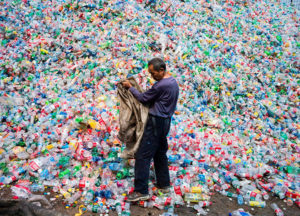Why iPhones Are Being Recycled and Bottles Aren’t
By Erick Roston
From Bloomberg Businessweek
Keep your plastics.
Photographer: Fred Dufour/AFP via Getty Images
Recycling, we hardly recognize you. Nearly a half-century after the first Earth Day, big companies are now among the biggest boosters of recycling in hopes of pleasing socially responsible investors and planet-conscious consumers. At the same time, a decision by the Chinese government is now sending some consumers’ carefully sorted bottles and boxes right into landfills, subverting the most traditional idea of recycling.
1. Which companies are big-time recyclers?
Under pressure from consumers, the list is growing. In January, McDonald’s Corp. announced a goal to recycle all food packaging it its stores by 2025. And the Coca-Cola Co. said it would aim for an average of 50 percent recycled content for its bottles by 2030. Apple Inc. has pledged “to one day end our reliance on mining altogether” — an ambitious goal, since smartphones have some five dozen different metals in them. Apple already offers customers the option of recycling iPhones and its other products at any of its stores or through the mail. Few companies have embraced sustainability more aggressively than Unilever Plc. Among its latest batch of goals is to offer only reusable, recyclable or compostable plastic in packaging by 2025. In 2017, the Association of Plastics Recyclers began recruiting companies to use more recycled plastics; companies like Proctor & Gamble Co., Target Corp. and Keurig Green Mountain Inc. have already signed on.
2. What impact has business recycling had?
It’s gotten good at reusing metals. Scrap aluminum in 2016 made up the equivalent of more than 30 percent of U.S. consumption. About a quarter, or 35,000 tons, of zinc refined in the U.S. comes from recovered materials. Thirty percent of U.S. cobalt in 2016 came from scrap, a number that may rise as electric car production ramps up. But globally, steel is far and away the most recycled material. For years, roughly a third of the world’s annual steel production has come from scrap. In 2013, the most recent year with data, about 300 car shredders in the U.S. turned 85 percent of defunct automobiles into 14 million tons of steel.
3. What did China do to affect consumer recycling?
In July, China notified the World Trade Organization that it would stop taking most recycled paper, plastics and other material starting Jan. 1, part of a campaign to rid itself of “foreign garbage.” China had been the largest user of scrap plastics, taking in more than half the world’s waste. Even before the ban took effect, solid-waste recycling inventories in the U.S. were already filling up, causing some recycling centers to tell their customers to just toss plastics into the trash.
4. Why did China stop the imports?
It’s part of a broad crackdown on pollution. Some processing plants for recycled materials were polluting surrounding neighborhoods by burning plastic and discharging waste water into rivers. China told the WTO that too much of the recycled material it had imported was contaminated — sometimes with hazardous waste — and couldn’t be reused. This doesn’t mean China will stop recycling, since it has its own growing piles of garbage to handle. For example, it’s estimated that there were 331 million packages delivered for the Singles Day shopping holiday on Nov. 11, which translated into roughly 160,000 tons of shipping material.
5. What are recycling exporters doing about this?
Theresa May announced in January that she wanted to extend the U.K.’s 5-pence charge on single-use plastic bags to smaller stores, which have been exempt, encourage plastic-free aisles in supermarkets and increase research into less-damaging plastic products. The European Union has said it will look at taxing single-use plastic items, like straws and coffee lids, which could also help it close the budget gap caused by the U.K. leaving the union. In the U.S., where there are no national recycling laws, communities are looking at ways to offer recycling centers better-quality supplies, in the hopes that it will increase the odds that consumer recyclables can be sold. For some, this means ending single-bin collection, which mixes plastic, metals and paper together, since this increases the chances that products like paper will be contaminated with things like oil from food containers.
6. What will happen to consumer recycling?
It’s possible that countries including India, Thailand and Vietnam could become bigger buyers. Local paper mills might benefit from the added supply of low-cost scrap to make cardboard. Some U.S. waste haulers are upgrading equipment and hiring more workers hoping to meet China’s strict new standards for clean materials. And recycling supporters hope this might spur the U.S. and other nations to finally move to a waste-free future. But in the near term, some communities have suspended collections and others are already sending recyclables to landfills.
7. What are environmentalists saying?
While they are all for recycling, they also say consumers should buy less stuff in the first place. Greenpeace has criticized Apple for making products that are only supposed to last three years. Greenpeace has also called out many companies, including Coca-Cola, Procter & Gamble, Unilever and McDonald’s for encouraging the use of cheap, disposable plastics that end up in the ocean.

